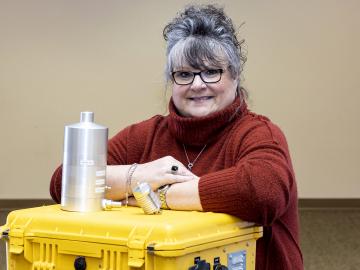Filter News
Area of Research
- Biology and Environment (11)
- Chemistry and Physics at Interfaces (1)
- Clean Energy (12)
- Energy Frontier Research Centers (1)
- Functional Materials for Energy (1)
- Fusion and Fission (2)
- Isotopes (3)
- Materials (1)
- Materials Synthesis from Atoms to Systems (1)
- Materials Under Extremes (1)
- National Security (1)
- Neutron Science (2)
- Supercomputing (2)
News Type
News Topics
- 3-D Printing/Advanced Manufacturing (3)
- Artificial Intelligence (1)
- Big Data (2)
- Bioenergy (4)
- Biology (7)
- Biomedical (2)
- Biotechnology (2)
- Buildings (3)
- Clean Water (1)
- Climate Change (2)
- Computer Science (2)
- Coronavirus (1)
- Cybersecurity (1)
- Decarbonization (2)
- Energy Storage (4)
- Environment (10)
- Exascale Computing (1)
- Fusion (1)
- Grid (2)
- High-Performance Computing (4)
- Isotopes (3)
- ITER (1)
- Materials Science (1)
- Mercury (1)
- National Security (2)
- Neutron Science (2)
- Nuclear Energy (1)
- Physics (1)
- Quantum Science (1)
- Security (1)
- Sustainable Energy (6)
- Transportation (5)
Media Contacts

Deborah Frincke, one of the nation’s preeminent computer scientists and cybersecurity experts, serves as associate laboratory director of ORNL’s National Security Science Directorate. Credit: Carlos Jones/ORNL, U.S. Dept. of Energy

For years Brenda Smith found fulfillment working with nuclear batteries, a topic she’s been researching as a chemist at Oak Ridge National Laboratory.

Belinda Akpa is a chemical engineer with a talent for tackling big challenges and fostering inclusivity and diversity in the next generation of scientists.

In his career focused on energy storage science, Jianlin Li has learned that discovering new ways to process and assemble batteries is just as important as the development of new materials.

From Denmark to Japan, the UK, France, and Sweden, physicist Ken Andersen has worked at neutron sources around the world. With significant contributions to neutron scattering and the scientific community, he’s now serving in his most important role yet.

Rich Giannone uses bioanalytical mass spectrometry to examine proteins, the primary driver in biological systems.

If a nation tries to hide a clandestine nuclear operation, Paula Cable-Dunlap and her team will give their all to help find it. Just don’t call their work “nuclear CSI” – not where she can hear, at least.

When Kashif Nawaz looks at a satellite map of the U.S., he sees millions of buildings that could hold a potential solution for the capture of carbon dioxide, a plentiful gas that can be harmful when excessive amounts are released into the atmosphere, raising the Earth’s temperature.

Nuclear physicist Caroline Nesaraja of the Department of Energy’s Oak Ridge National Laboratory evaluates nuclear data vital to applied and basic sciences.

Cory Stuart of ORNL applies his expertise as a systems engineer to ensure the secure and timely transfer of millions of measurements of Earth’s atmosphere, fueling science around the world.




